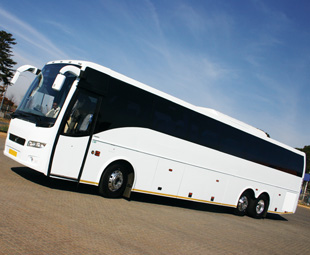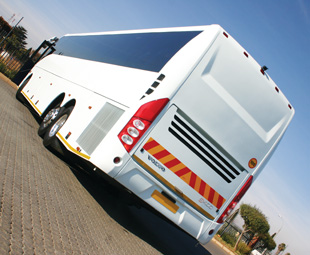Experiencing the exceptional

This month Vic Oliver road tests the Volvo 9400 coach.
The Volvo 9400 coach presented to FOCUS to test was one of the first buses to be built at the company’s new bus plant at Hosakote near Bangalore in India and exported to South Africa. This plant is the latest addition to Volvo’s global manufacturing facilities.
The plant follows strict conformance to Volvo’s global business practices and production principles, assuring customers of high quality workmanship and product integrity.
The 70-seater test coach is designed for a city-to-city type of operation offering the customer maximum vehicle availability with minimum maintenance, ease of repair and low fuel consumption.
The test route was from the Volvo offices in Jet Park, along the N12 freeway to Witbank and back, covering a distance of 240,7 km.
The fuel consumption achieved on the test run was 25,3 l/100 km (3,95 km/litre.) However, it must be noted that the test was conducted with no passengers and luggage, and operated at a maximum speed of 100 km/h. My estimated fuel consumption with a fully loaded coach would be 33,3 l/100 km (3 km/litre), which is very economical for a 70-seater three-axle coach.
Three fuel tanks are fitted, with a total capacity of 600 litres. With 600 litres of fuel, the coach could travel 1 800 km without refuelling, an added benefit in city-to-city operations. Another attractive feature is that the fuel tanks can be filled from both sides of the coach, making re-fuelling an easy task.
During the pre-trip inspection of the coach I found that all the daily checks were easily accessible.
 On the road the coach performed exceptionally well and proved to be very easy to drive, thanks to the Volvo I-Shift 12-speed manual gearbox with an automatic gear changing system. Although the vehicle does not have a clutch pedal, a clutch is still necessary. The clutch is automatically engaged when starting the drive. Once the vehicle is in motion, gear changing is done without the use of the clutch, which in turn extends clutch life and reduces maintenance costs and vehicle down time, and is an added operational benefit.
On the road the coach performed exceptionally well and proved to be very easy to drive, thanks to the Volvo I-Shift 12-speed manual gearbox with an automatic gear changing system. Although the vehicle does not have a clutch pedal, a clutch is still necessary. The clutch is automatically engaged when starting the drive. Once the vehicle is in motion, gear changing is done without the use of the clutch, which in turn extends clutch life and reduces maintenance costs and vehicle down time, and is an added operational benefit.
The ride comfort for the passengers is good due to the well-designed seats, effective air-conditioner, large tinted windows and good interior personal luggage space. A computer plug socket at each seat is also available for passenger convenience plus three TV monitors.
The power delivered by the rear-mounted Volvo model D9B engine proved to be well matched for the operation, producing sufficient power for the coach to achieve high vehicle productivity, without high fuel consumption. On the test run we were able to maintain our cruising speed of 100 km/h on most of the route. At 100 km/h the engine is revving at 1 480 r/min, which is right in the middle of the green band, where the engine produces its maximum torque and best fuel economy, indicating excellent gearing ratios.
Other good engine features are the five-minute limit on engine idle plus the control on the engine revolutions while the engine is cold after start-up. The maximum engine revolutions and vehicle speed can also be set by Volvo to suit the operational conditions before the vehicle is delivered to the customer. The test coach maximum operating speed was set for 110 km/h.
To ensure high durability, the engine is fitted with only two V-belts, one to drive the twin alternators and the other to drive the large air-conditioner.
Driver and passenger visibility is good. In my opinion the front sun visor is too large covering the entire width of the front windscreen and clumsy to operate. The tie-back brackets fitted on the front inside windscreen pillars to hold the visor operating controls are crudely made from steel without any safety protection. These unprotected steel brackets could cause injury to the driver and passengers in the event of an accident. According to Volvo, the front visor finishing is being addressed and will be improved on the next units arriving in SA.
The noise level inside the coach is good, except at the rear of the coach, where the axles are noisy. However, once the underbelly luggage compartments are full, the noise from the rear axles should be dampened.
A total of 11 m³ of luggage space is provided plus a sleeper compartment for the second driver. This sleeper compartment is fitted next to the luggage compartment and is equipped with a large comfortable mattress, air-conditioner and intercom connected to the driver’s cabin.
This Indian-built coach is well priced and together with the excellent renowned Volvo quality and back-up service offered by Volvo South Africa and its network of local dealers, we can expect to see many more of these coaches on our roads in the future.
Published by
Focus on Transport
focusmagsa



